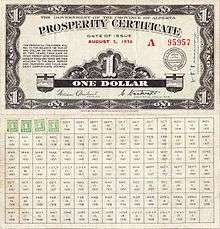Prosperity certificate

In 1936, the Alberta Social Credit Party-led government of the Province of Alberta, Canada, introduced prosperity certificates in an attempt to alleviate the effects of the Great Depression. Social Credit Premier William Aberhart's government had won power in the 1935 provincial election partly on the scheme.
Although not technically money, each certificate was intended to circulate with a value of one dollar. The intent of the program was to keep the certificates circulating and discourage hoarding. To achieve this, a holder had to affix to the back of a certificate a 1-cent stamp before the end of every week, for the certificate to maintain its validity. But the hassle and expense of the stamps made the certificates unpopular with the public. To make matters worse, the tiny postage-style stamps (smaller than 1 cm²) were prone to falling off. As the program intended, possessors of the certificates tried to avoid having to purchase and affix the stamps, by spending the certificates before the week's validity expired. The certificates then fell into in the hands of merchants, who would then purchase and affix stamps to maintain the notes' validity.
The notes were intended to be redeemed after two years of issue, when 104 stamps would have been affixed. But the program was cancelled after only about one year.[1]
See also
References
- ↑ Charlton Standard Catalogue of Canadian Government Paper Money, ISSN 1716-0731, 18th edition, p. 13. Charlton Press.